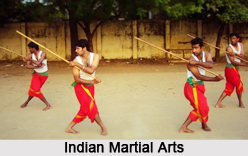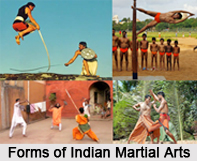 Indian martial arts display a great diversity in their form and type, in keeping with the country's rich and varied culture. Now, in India, martial art is a necessity for every people. It is necessary for women also.
Indian martial arts display a great diversity in their form and type, in keeping with the country's rich and varied culture. Now, in India, martial art is a necessity for every people. It is necessary for women also.Origin of Indian Martial Arts
Each region in India practices its own unique martial arts discipline with great vigour and enthusiasm. The Sanskrit language term for martial arts is 'Dhanur Veda', derived from the terms dhanus meaning 'bow' and veda meaning 'knowledge'. Thus, it literally translates into the science of archery. Since ancient times, martial arts have constantly been referenced in various literary texts, indicating their long course of development and refining.
History of Indian Martial Arts
The history of martial arts can be traced over a greatly extended period of time. Early martial traditions go back to the 2nd millennium BC. The Agni Purana is arguably the earliest extant manual of Dhanurveda which talks about the art of war in five detailed parts. It was duly mentioned in Vedic literature like the Rig Veda, Yajur Veda and Atharva Veda. The tome described how to improve a warrior's individual artistry and kill enemies using various different methods in warfare, whether a warrior went to war in chariots, elephants, horses, or on foot.

Indian Martial Arts in Mahabharata
Numerous references to Indian martial arts are found scattered throughout the Mahabharata. The vivid descriptions of martial artistry are found in the contest between Arjuna and Karna, who use bows and swords, trees and rocks, and eventually fists in unarmed battle; and fighters boxing with clenched fists and fighting with kicks, finger strikes, knee strikes and head butts.
Indian Martial Arts in Ramayana
Ramayana also has the reference of Indian Martial arts. Among the various Indian martial arts, Malla-yuddha was regarded as prominent in that era. It is a form of combat wrestling codified into four forms which is described in the ancient Indian epics as the fighting style of warriors such as Bhima.
For more visit the link below: